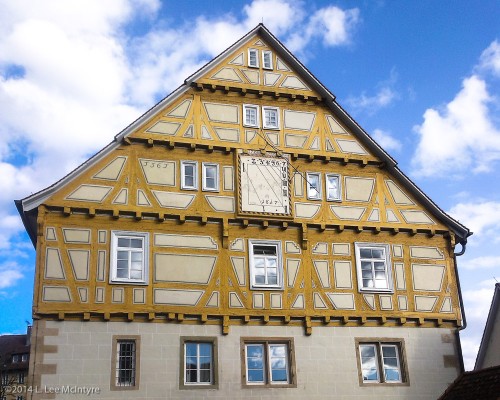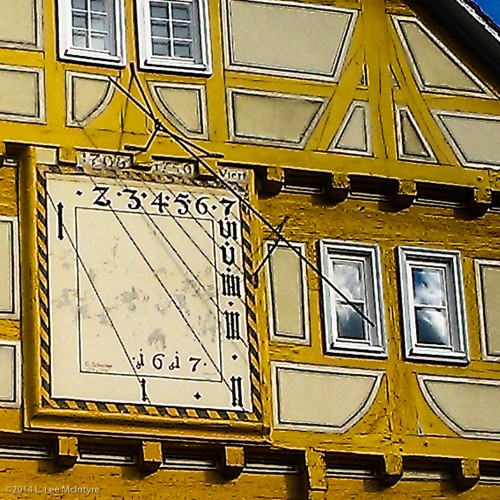Today on Monday Mysteries we learn about the ornate, huge sundial in Tübingen that only counts from 2-7.
Now, there are actually several sundials here in Tübingen, and most of the sundials are small. However, the sundial we’re going to talk about today is by far the biggest and most ornate sundial we’ve seen in Tübingen, but it also the most curious. It’s located on side of the old Evangelisches Stift, the Evangelical seminary. The half-timbered style building was constructed in the 1500s, but the sundial is dated 1617, so I guess it was a later addition.
The curious thing about this sundial is that is designed to tell time only in the afternoon, since note that the numbers only go from 2 -7. That’s because this dial faces west, which means the sun doesn’t reach it until after 2pm in the afternoon.
The sun was out, but not strongly, at 3pm this afternoon when I took that photo. Below is another photo where I’ve zoomed in on the sundial face. if you look closely, you can see that there’s a faint shadow line that crosses the 3. The rest of those lines you see there are painted on the sundial, for reference when telling time, I guess; it’s a bit cluttered, IMHO.
A local historian interviewed for that Geheimnis book speculates that the sundial was placed on this western side of the building so that it would point in the Richtung des Ephorats. Richtung des Ephorats is German for “direction of the Ephorats.”
Right – the question becomes understanding what Ephorats means. Unfortunately, all the German dictionaries I’ve checked, both online and paper, do not give a translation for Ephorats. But then, I noticed that the dictionary did have an entry for Ephoren in German. Now, it seems plausible to me to imagine that the German word Ephorat could mean a place where the Ephoren are. So, I looked up Ephoren, to see what that meant.
Simple. It’s plural for Ephor.
Which means “ephor” in English.
Ah, well, that cleared that right up, didn’t it. Or not. Maybe that’s that a common word in Britain; the dictionary I’m using translates using British words, not American. As an American, I’d never heard that word before at least.
Anyway, looking up “ephor” in an online English dictionary, I finally get to a definition that suggests it is etymologically connected to words used for “overseer”, originating from a term used in ancient Greece – in Sparta, specifically. But there is a note that it was also used more generally for “overseer” or “headmaster”.
OK, now we’re on to something. So, here’s my guess as to what the historian meant. Here in Tübingen, they added the sundial to the seminary building on the side of the building where the headmasters had a clear view of it. That way, the headmasters could keep tabs on the afternoon comings and goings of the students in the seminary. In other words, the idea is that it was added on that side, as opposed to the south side (the usual side for sundials), specifically to make sure the Ephors could see easily track who was late, who had left, etc.
Seems plausible.
Of course, Chris’ alternate explanation for why the sundial is on the western side of the building is simpler. He speculates that because of the position of this building — where it is on the street, where it is with relation to the river, and where it would have been in relation to the (no longer standing) old city walls — the western side was the only one with any chance of getting any sun at all.
I don’t know. Those both seem like plausible answers. But time after time I’ve stood and looked at this sundial and wondered why someone would go to all that trouble to build such a fancy yellow one on a western wall where it only can tell the time for a few hours each day.
What do you think? I think it’s about time … that I give my faithful readers here on Two to Tü a chance to shine a different light on this question. 😉
******
Writing that phrase “time after time” reminded me of a song by Cyndi Lauper by that name, Time after Time, so here’s a link to her performance of it. But my favorite version of that song is the way it is performed by Tuck and Patti.



A sundial on a flat wall is going to be limited to just a few hours’ measurements a day, so Chris’s explanation makes a lot of sense,
But thinking about the daylight hours during which mischief is going to be done, isn’t it more likely to be from 2 to 7 than during the earlier hours? In which case, your (linguistically fascinating) hypothetical overseers definitely made the right choice.
Thanks, Will. Who ever thought linguistics would be the key to understanding the reasons behind a sundial, eh? 😉